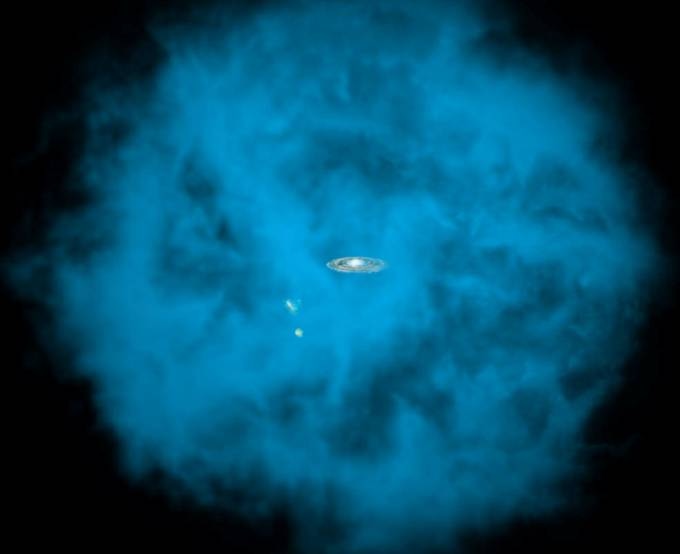Jul 26 2016
For the first time, astronomers from the University of Michigan’s College of Literature, Science, and the Arts (LSA) have identified that the hot gas in the halo of the Milky Way is spinning in the same direction and at a similar speed to the galaxy's disk, which holds our planets, stars, gas and dust.
 Our Milky Way galaxy and its small companions are surrounded by a giant halo of million-degree gas (seen in blue in this artists' rendition) that is only visible to X-ray telescopes in space. University of Michigan astronomers discovered that this massive hot halo spins in the same direction as the Milky Way disk and at a comparable speed. Credits: NASA/CXC/M.Weiss/Ohio State/A Gupta et al
Our Milky Way galaxy and its small companions are surrounded by a giant halo of million-degree gas (seen in blue in this artists' rendition) that is only visible to X-ray telescopes in space. University of Michigan astronomers discovered that this massive hot halo spins in the same direction as the Milky Way disk and at a comparable speed. Credits: NASA/CXC/M.Weiss/Ohio State/A Gupta et al
This finding provides an insight into how individual atoms have come together to form planets, stars and galaxies similar to our own, and the future of these galaxies.
This flies in the face of expectations. People just assumed that the disk of the Milky Way spins while this enormous reservoir of hot gas is stationary - but that is wrong. This hot gas reservoir is rotating as well, just not quite as fast as the disk.
Edmund Hodges-Kluck, Assistant Research Scientist, UM LSA
The new data obtained from the NASA-funded research that used a European Space Agency telescope, XMM-Newton, was published in the Astrophysical Journal. The research concentrates on the hot gaseous halo, which is made of ionized plasma and IS several times larger than the Milky Way disk.
As motion creates a shift in the wavelength of light, the investigators measured such shifts around the sky with lines of very hot oxygen. They found that the galaxy’s halo rotates in the same direction as the Milky Way’s disk and at a similar speed of about 400,000 mph for the halo against 540,000 mph for the disk.
The rotation of the hot halo is an incredible clue to how the Milky Way formed. It tells us that this hot atmosphere is the original source of a lot of the matter in the disk.
Edmund Hodges-Kluck, Assistant Research Scientist, UM LSA
Almost all galaxies including the Milky Way, have been studied by researchers but they seem to lack a lot of matter that was expected to be found. Astronomers maintain that the mysterious “dark matter”, identified only by its gravitational pull, accounts for about 80% of the missing matter.
However, a majority of the existing 20% of normal matter is also missing from galaxy disks. Some of the missing matter has recently been identified in the halo. The U-M investigators said that further knowledge about the speed and direction of the spinning halo can help them to understand how the material actually got there, and the speed at which they expect the matter to settle down in the galaxy.
Now that we know about the rotation, theorists will begin to use this to learn how our Milky Way galaxy formed – and its eventual destiny. We can use this discovery to learn so much more – the rotation of this hot halo will be a big topic of future X-ray spectrographs.
Joel Bregman, Professor of Astronomy, UM LSA